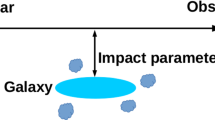Abstract
DETERMINATION of the density and ionization state of diffuse primordial gas in the intergalactic medium (IGM) is an important step towards understanding the nature of dark matter and the formation of structure in the Universe. Absorption by neutral hydrogen atoms in the IGM should produce a large flux deficit in the spectra of high-redshift quasars at wavelengths below that of the H I Lyman-α line (the Gunn–Peterson effect1). But observations of quasars at low spectral resolution have revealed only relatively small deficits, and at higher spectral resolution these appear as numerous discrete absorption features (the Lyman-α forest). This implies that intergalactic hydrogen is both highly ionized and non-uniformly distributed2. Similar absorption is expected from intergalactic helium3, although its detection is more challenging and evidence for its existence was obtained only recently4,5. Here we report the observation of absorption from singly ionized helium (He ii) in the spectrum of the quasar HS1700 + 64. We measure a mean flux deficit over the redshift range 2.2 < z < 2.6 that yields an effective optical depth of 1.00 (±0.07). Comparing this result with the H I absorption towards this quasar, we argue that most of the measured He II absorption occurs in the lowest-density regions of the IGM.
Similar content being viewed by others
References
Gunn, J. E. & Peterson, B. A. Astrophys. J. 142, 1633–1636 (1965).
Sargent, W. L. W., Young, P. J., Boksenberg, A. & Tytler, D. Astrophys. J. Suppl. Ser. 42, 42–48 (1980).
Miralda-Escudé, J. Mon. Not. R. astr. Soc. 262, 273–276 (1993).
Jakobsen, P. et al. Nature 370, 35–39 (1994).
Tytler, D. et al. in QSO Absorption Lines (eds Bergeron, G., Meylan, G. & Wampler, J.) 289–298 (Springer, Heidelberg, 1995).
Jakobsen, P. et al. Astrophys. J. 417, 528–540 (1993).
Davidsen, A. F. et al. Astrophys. J. 392, 264–271 (1992).
Davidsen, A. F. Science 257, 327–334 (1993).
Reimers, D. et al. Astr. Astrophys. 218, 71–77 (1989).
Vogel, S. & Reimers, D. Astr. Astrophys. 294, 377–410 (1995).
Kruk, J. W. et al. Astrophys. J. 454, L1–L6 (1995).
Zheng, W. & Davidsen, A. F. Astrophys. J. 440, L53–L56 (1995).
Giroux, M. L., Fardal, M. A. & Shull, M. J. Astrophys. J. 451, 477–483 (1995).
Oke, J. & Korycanski, D. G. Astrophys. J. 255, 11–19 (1982).
Press, W. H., Rybicki, G. B. & Schneider, D. P. Astrophys. J. 414, 64–81 (1993).
Hu, E. M., Kim, T.-S., Cowie, L. L., Songaila, A. & Rauch, M. Astr. J. 110, 1526–1543 (1995).
Songaila, A., Hu, E. M. & Cowie, L. L. Nature 375, 124–126 (1995).
Reisenegger, A. & Miralda-Escudé, J. Astrophys. J. 449, 476–487 (1995).
Rodríguez-Pascual, P. M. et al. Astrophys. J. 448, 575–588 (1995).
Miralda-Escudé, J. & Ostriker, J. P. Astrophys. J. 350, 1–22 (1990).
Madau, P. & Meiksin, A. Astrophys. J. 433, L53–L56 (1994).
Haardt, F. & Madau, P. Astrophys. J. (in the press).
Cen, R., Miralda-Escudé, J., Ostriker, J. P. & Rauch, M. Astrophys. J. 437, L9–L12 (1994).
Miralda-Escudé, J., Cen, R., Ostriker, J. P. & Rauch, M. Astrophys. J. (in the press).
Hemquist, L., Katz, N., Weinberg, D. H. & Miralda-Escudé, J. Astrophys. J. 457, L51–L56 (1996).
Cardelli, J., Clayton, G. & Mathis, J. Astrophys. J. 345, 245–256 (1989).
Burstein, D. & Heiles, C. Astrophys. J. 225, 40–55 (1978).
Stark, A. A. et al. Astrophys. J. Suppl. Ser. 79, 77–104 (1992).
Eastman, R. G. & MacAlpine, G. M. Astrophys. J. 299, 785–798 (1985).
Netzer, H., Elitzur, M. & Ferland, G. Astrophys. J. 299, 752–762 (1985).
Jenkins, E. B. & Ostriker, J. P. Astrophys. J. 376, 33–42 (1991).
Dobrzycki, A. & Bechtold, J. Astrophys. J. 377, L69–L72 (1991).
Author information
Authors and Affiliations
Rights and permissions
About this article
Cite this article
Davidsen, A., Kriss, G. & Zheng, W. Measurement of the opacity of ionized helium in the intergalactic medium. Nature 380, 47–49 (1996). https://doi.org/10.1038/380047a0
Received:
Accepted:
Issue Date:
DOI: https://doi.org/10.1038/380047a0
- Springer Nature Limited
This article is cited by
-
The James Webb Space Telescope
Space Science Reviews (2006)
-
The First Cosmic Structures and Their Effects
Space Science Reviews (2005)





